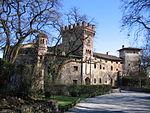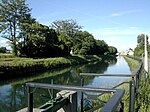The Naviglio della Martesana (Lombard: Nivili de la Martexana or Martesanna [niˈʋiːri de la marteˈzana]) is a canal in the Lombardy region, Northern Italy. Running from the Adda river, in the vicinity of Trezzo sull'Adda, to Milan, it was also known as Naviglio Piccolo (Lombard: Navijett [naʋiˈjɛt]). It is part of the system of navigli of the Milan area.
Approximately 38 kilometres (24 mi) long, with a substantial section covered over or infilled, its width varies between 9 and 18 metres (30 and 59 ft), while the depth is between one and three metres (3 and 10 ft).
Originally named Naviglio Piccolo, it subsequently changed to Martesana from the name of the county across which it runs.
Along the way it crosses the boundaries of the villages of Trezzo sull'Adda, Vaprio d'Adda, Cassano d'Adda, Inzago, Bellinzago Lombardo, Gessate, Gorgonzola, Bussero, Cassina de' Pecchi, Cernusco sul Naviglio and Vimodrone, and takes the name Martesana from this area (Martesana County was established during the late Roman ages).
The canal enters Milan alongside Via Padova until Cassina dei Pom: at the junction with Via Melchiorre Gioia it disappears underground following the route of Via Melchiorre Gioia itself southwards. In the past it would have passed through the Fossa dell'Incoronata and the Laghetto di San Marco to connect with the Fossa Interna (or Inner Ring). Today, after merging with the river Seveso, the underground course becomes the Cavo Redefossi in the vicinity of Porta Nuova, runs under the cerchia dei bastioni to Porta Romana, follows Corso Lodi and Via Emilia, finally ending up in the River Lambro.











